|
|
|
|
|
Oil On
Canvas, Real Flavor of Old Masters
|
|

|
ARTWORKS
INDEX
A B C D E F G H I J K L M N O P Q R S T U V W X Y Z |
ARTISTS
INDEX
A B C D E F G H I J K L M N O P Q R S T U V W X Y Z |
|
|
| | |
|
|
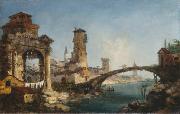 |
Workshop of Michele Marieschi -- Click Here
|
|
painted Fantastic landscape with ruins in 1730s
|
|
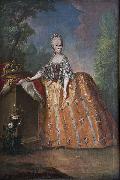 |
Workshop of Anton von Maron -- Click Here
|
|
Anton von Maron (January 8, 1733 - March 3, 1808) was an Austrian painter, active in Rome.
Von Maron was born in Vienna, but moved at a young age to Rome. There, he studied under Anton Raphael Mengs, and became an accomplished portrait painter. He married a sister of Mengs, Therese Maron, who was a painter in her own right. He lived the rest of his life in Rome, and died there in 1808. |
|
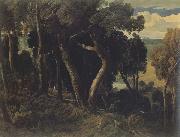 |
William Turner of Oxford -- Click Here
|
|
British, 1789-1862
He probably received his earliest training from William Delamotte, in Oxford. In 1804 he went to London and became a pupil of John Varley, possibly being formally apprenticed. He first exhibited at the Royal Academy in 1807; in January 1808 he was elected an associate of the Society of Painters in Water-Colours, and in November of that year became its youngest full member. He exhibited there annually from 1808 until his death, sending 455 works in all. His passionate, technically complex youthful work was highly acclaimed, yet its promise remained unfulfilled; around 1811 he returned to Oxfordshire and soon established himself as a drawing-master in Oxford. |
|
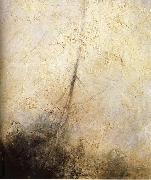 |
William Turner -- Click Here
|
|
English Romantic Painter, 1775-1851
British painter and printmaker. He dominated British landscape painting throughout the first half of the 19th century. He established a reputation in the Royal Academy, London, first as a topographical watercolourist and then within a few years as a painter of Sublime and historical landscapes. |
|
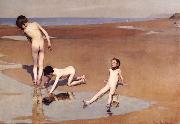 |
William Stott of Oldham -- Click Here
|
|
British , 1857-1900 |
|
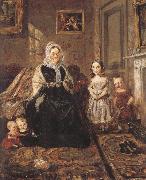 |
william holman hunt,o.m.,r.w.s -- Click Here
|
|
1827-1910
English painter. He worked as an office clerk in London from 1839 to 1843, attending drawing classes at a mechanics' institute in the evenings and taking weekly lessons from the portrait painter Henry Rogers. Holman Hunt overcame parental opposition to his choice of career in 1843, and this determined attitude and dedication to art could be seen throughout his working life. In July 1844, at the third attempt, he entered the Royal Academy Schools. His earliest exhibited works, such as Little Nell and her Grandfather (exh. British Institution, 1846; Sheffield, Graves A.G.), reveal few traces of originality, but the reading of John Ruskin's Modern Painters in 1847 was of crucial importance to Holman Hunt's artistic development. It led him to abandon the ambitious Christ and the Two Marys (Adelaide, A.G. S. Australia) in early 1848, when he realized its traditional iconography would leave his contemporaries unmoved. His next major work, the Flight of Madeline and Porphyro during the Drunkenness Attending the Revelry (1848; London, Guildhall A.G.), from John Keats's 'Eve of St Agnes', though displaced into a medieval setting, dramatized an issue dear to contemporary poets and central to Holman Hunt's art: love and youthful idealism versus loyalty to one's family. His first mature painting, it focuses on a moment of psychological crisis in a cramped and shallow picture space. |
|
|
|
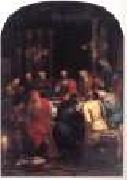 |
VEEN, Otto van -- Click Here
|
|
Flemish painter (b. 1556, Leiden, d. 1629, Bruxelles).
Flemish painter and draughtsman of Dutch birth. Although born in Holland, he is regarded as an artist of the Catholic southern Netherlands, where he spent most of his active life. He seems to have been acquainted with most of the Netherlandish scholars of his time, and his works testify to his broad humanistic learning. This and his prominent role in the early manifestations of the Counter-Reformation in Antwerp may have led Rubens to choose him as a teacher. Van Veen's importance as an artist has often been compared to the career of his famous pupil, for whom he was certainly the most important exemplar of the pictor doctus or learned painter. Van Veen obviously represents the older generation's more classicizing and conservative response to the Counter-Reformation. For him, the return to the spiritual values of the past also implied a recovery of the pictorial style of the High Renaissance, with its deliberate borrowings from the paintings of such artists as Raphael and Correggio. |
|
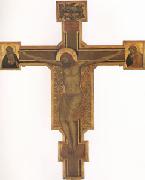 |
studio of giotto -- Click Here
|
|
b. 1267, Vespignano, d. 1337, Firenze |
|
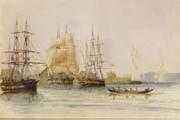 |
Stanley, Owen -- Click Here
|
|
1811 - 1850,was commander of HMS Rattlesnake on a four year exploratory expedition to New Guinea, 1846?C1850. Stanley was the son of Edward Stanley, Bishop of Norwich. He left naval college at the age of fifteen, and served under Phillip Parker King on HMS Adventure and John Franklin in the Mediterranean. In 1836 he sailed to the Arctic as scientific officer on HMS Terror under George Back. In 1838 he was given command of HMS Britomart and sailed to Australia, returning in 1843. In December 1846 Stanley sailed from Portsmouth in charge of HMS Rattlesnake, with the purpose of surveying the seas around the Great Barrier Reef and Torres Strait. The ship called at Madeira, Rio de Janeiro, Simon's Town and Mauritius, arriving in Sydney in July 1847. |
|
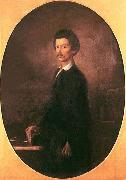 |
Soma Orlai Petrich -- Click Here
|
|
(October 22, 1822, Mezőbereny - June 5, 1880, Budapest) was a Hungarian painter. Petrich was born to a Serbian father and Hungarian mother.
He originally wanted to become a writer. He was a pupil of Jakab Marastoni in 1846 and attended Ferdinand Georg Waldmeller's school in Vienna from 1847. He often painted historical themese and in his lithographs he portrayed experiences during the war of independence. He studied from Kaulbach in Munich from 1850. He painted "The Corpse of Louis II" in 1851, a decade before Bertalan Szekely's painting. He was also a popular portraitist.
|
|
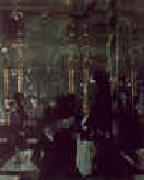 |
Sir William Orpen -- Click Here
|
|
Irish
1878-1931
Sir William Orpen Location
Irish painter. He attended the Metropolitan School of Art, Dublin (1891-7), and the Slade School of Art, London (1897-9), there winning the composition prize of 1899 with The Play Scene from Hamlet (Houghton Hall, Norfolk). He became a friend of Augustus John and joined the New English Art Club. From very early years he had been an impassioned student of the Old Masters, and he went to Paris with John in 1899 to see Leonardo da Vinci Mona Lisa (Paris, Louvre). In the following years his perception of their works |
|
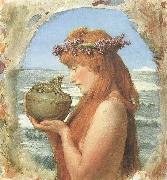 |
Sir Lawrence Alma-Tadema,OM.RA,RWS -- Click Here
|
|
1836-1912
|
|
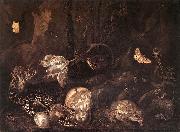 |
SCHRIECK, Otto Marseus van -- Click Here
|
|
Dutch Baroque Era Painter, 1619-1678
Dutch painter. According to Houbraken, he travelled to Italy and stayed in Rome and Florence with the painters Matthias Withoos and Willem van Aelst, the latter his pupil at the time. Among his patrons were Ferdinando II de' Medici, Grand Duke of Tuscany (reg 1621-70). Van Hoogstraten claimed that he met van Schrieck in Rome as late as 1652. In Rome, van Schrieck was a member of the Schildersbent. About 1657 he returned with van Aelst to Amsterdam, where he had a small property and got married on 25 April 1664. An inventory of the contents of his house was made in July 1678, shortly after his death, in which more than 300 paintings are listed. Besides his own paintings, there were works by Cornelis van Poelenburch, Simon de Vlieger, Ludolf Bakhuizen, Jan Wijnants, Lucas van Leyden |
|
 |
School of Latium -- Click Here
|
|
First half of the thirteenth century |
|
|
|
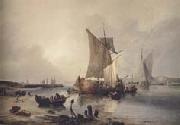 |
Samuel Owen -- Click Here
|
|
(1769-1857), Watercolour painter |
|
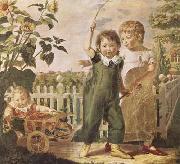 |
Philipp Otto Runge -- Click Here
|
|
German Romantic Painter, 1777-1810
..German painter, draughtsman and theorist. He stands alongside Caspar David Friedrich as a leading figure in German Romantic painting even though his early death restricted his oeuvre to relatively few stages of development. The enduring prominence of philosophical and theoretical concerns suggests that further work would have contributed to the history of ideas as well as to that of art. Runge's greatest influence was on later, largely 20th-century artists and thinkers rather than on his immediate contemporaries. While 19th-century developments certainly bore out Runge's claim for a new, symbolic role for landscape, |
|
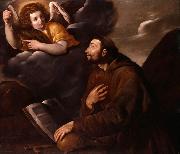 |
Pasquale Ottino -- Click Here
|
|
(Verona, 1578 - Verona, 1630) was an Italian painter.
Born in Verona in 1578, Ottino learned his trade in the workshop of Felice Brusasorci together with Alessandro Turchi, known as Orbetto, with whom he completed the Fall of Manna in the church of San Giorgio in Braida, left unfinished on the masteres death in 1605. His early works attest to the decidedly Mannerist character of the initial phase of his career. The sources indicate fairly constant activity in his hometown, even though there are still some doubts as to the reconstruction of his artistic career, especially incongruities regarding a trip to Rome that may have taken place with his companions Turchi and Bassetti around 1615. He died of plague in Verona in 1630.
|
|
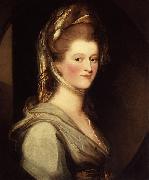 |
Ozias Humphry -- Click Here
|
|
Ozias Humphry (or Humphrey) (8 September 1742 -9 March 1810) was a leading English painter of portrait miniatures, later oils and pastels, of the 18th century. He was elected to the Royal Academy in 1791, and in 1792 he was appointed Portrait Painter in Crayons to the King.
Born and schooled in Honiton, Devon, Humphrey was attracted by the gallery of casts opened by the Duke of Richmond and came to London to study art at Shipley's school. He also studied art in Bath (under Samuel Collins, taking over his practice in 1762); in Bath, he lodged with Thomas Linley. As a young artist, his talent was encouraged by Thomas Gainsborough and Sir Joshua Reynolds, among others. His problems with his sight, which ultimately led to blindness, began in the early 1770s and forced him to paint larger works in oils and pastel.
He travelled to Italy in 1773 with his great friend George Romney, stopping en route at Knole, near Sevenoaks in Kent, where the Duke of Dorset commissioned several works from him. His stay in Italy lasted until 1777.
On his return, his numerous subjects included George Stubbs (1777), fellow academician Dominic Serres, the chemist Joseph Priestley, and a portrait claimed to be of the teenage Jane Austen, from perhaps as early as 1790 (clothing styles suggest a later date), known as the "Rice" portrait after a later owner, though this has always been a controversial attribution of the sitter. This failed to reach its minimum estimate in a Christies auction in April 2007, and was withdrawn from sale. His pupils included John Opie. He compiled a fifty-page manuscript A Memoir of George Stubbs, based on what Stubbs had related to him; it is the only contemporary biography. This was edited and privately published in the 1870s and republished in 2005. He also knew William Blake and commissioned copies of some of his illustrated books. At least one of Blake's letters to him is a significant document for Blake's biographers. |
|
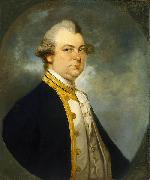 |
Ozias Humphrey -- Click Here
|
|
(8 September 1742 - 9 March 1810) was a leading English painter of portrait miniatures, later oils and pastels, of the 18th century. He was elected to the Royal Academy in 1791, and in 1792 he was appointed Portrait Painter in Crayons to the King.
Born and schooled in Honiton, Devon, Humphrey was attracted by the gallery of casts opened by the Duke of Richmond and came to London to study art at Shipley's school. He also studied art in Bath (under Samuel Collins, taking over his practice in 1762); in Bath, he lodged with Thomas Linley. As a young artist, his talent was encouraged by Thomas Gainsborough and Sir Joshua Reynolds, among others. His problems with his sight, which ultimately led to blindness. |
|
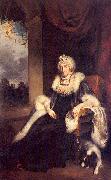 |
Owen, William -- Click Here
|
|
English, 1769-1825
English painter. The son of a bookseller, he was educated at the grammar school in Ludlow and was sent to London in 1786 to study under Charles Catton the elder (1728-98), coach painter to George III and founder-member of the Royal Academy. Owen's copy of a work by Reynolds, made soon after his arrival, attracted the latter's attention. He entered the Royal Academy Schools in 1791 and exhibited at the Royal Academy the following year. From then on he exhibited there every year, apart from 1823 and 1825, and was elected ARA in 1804 and RA in 1806. He painted a number of rural scenes but specialized in portrait painting. Although his reputation was eclipsed by that of Thomas Lawrence, he was sought after by many of the eminent figures of the day, producing portraits of the Archbishop of Canterbury, Dr William Howley (1813), and of the politician and essayist John Wilson Croker (exh. 1812; both London, N.P.G.); other of his sitters were William Pitt the younger and John Soane. In 1810 he was appointed portrait painter to the Prince of Wales (later George IV) and in 1813 principal portrait painter to the Prince when the latter became Prince Regent. The Prince Regent does not seem to have sat to him but nonetheless he offered Owen a knighthood, which the painter refused. From c. 1820 Owen's health deteriorated until a disease of the spine confined him to his room and finally rendered him incapable of painting. He died after accidentally taking a bottle of opium that had been wrongly labelled. |
|
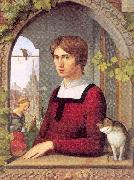 |
Overbeck, Johann Friedrich -- Click Here
|
|
German Painter, 1789-1869
German religious painter. Expelled from the Vienna Academy because of his opposition to its classicism, he went to Rome and with Peter von Cornelius, Veit, Schadow-Godenhaus, and others, formed the group known as the Nazarenes. His first real successes were his frescoes for the Casa Bartholdy (now in Berlin) and for the Villa Massimo. Among his notable paintings are Christ's Entry into Jerusalem and Christ's Agony in the Garden. Overbeck sought to make his art serve religion. |
|
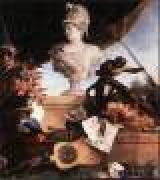 |
OUDRY, Jean-Baptiste -- Click Here
|
|
French Baroque Era Painter, 1686-1755
French painter. He was the principal animal painter and one of the foremost decorative painters during the first half of Louis XV's reign. After initial training as a portrait painter, he concentrated on still-lifes; by the 1720s he had also begun to establish himself as a specialist in hunting scenes, game-pieces and portraits of animals. He ran an active workshop, often keeping his best originals for years and selling copies and (more or less autograph) variants. In the 1730s he was most active as a tapestry designer, making numerous designs for the royal tapestry works of Beauvais and the Gobelins, and he continued to produce his brilliantly painted hunts, still-lifes and studies of animals and birds to the end of his career. |
|
 |
Otto Scholderer -- Click Here
|
|
(25 January 1834 - 22 January 1902) was a German painter.
He was born in Frankfurt am Main. On completing his schooling, Scholderer went to the Städel academy of arts in 1849, where he remained until 1851. Among his teachers were the art historian Johann David Passavant and the painter Jakob Becker. Subsequently, Scholderer established himself in Städel as a freelance painter. During this period his friendship with Victor Meller began; Scholderer became his brother-in-law in 1868.
Through Meller, Scholderer became acquainted with the works of Gustave Courbet. Scholderer made several short study trips to Paris between 1857 and 1858, where he became friends with Henri Fantin-Latour and Édouard Manet, whose influence can be seen in his subsequent work. Fantin-Latour depicted Scholderer in his picture Studio aux Batignolles . Starting from 1858, Scholderer worked and lived predominantly in Kronberg in Taunus, where his colleagues included Anton Burger, Peter Burnitz and Louis Eysen; he was close to the Kronberger painter colony.
In 1866, Scholderer established himself in Desseldorf and made friends with Hans Thoma. With Thoma, Scholderer went in 1868 to Paris and returned to Germany only shortly before the outbreak of the French-German War. First Scholderer established himself in Munich, renewing his friendship with Wilhelm Leibl and becoming one of the artists of the Leibl-Kreis (Leibl circle). At the beginning of 1871 he went to London and worked there till the autumn of 1899. After 1899, Scholderer returned to his hometown of Frankfurt, where he died at the age of almost 68 years on 22 January 1902.
Otto Scholderer's art, initially dominated by landscapes, later consisted primarily of portraits and still lifes. The important connection between the romantic period and the Impressionists is evident in his work.
|
|
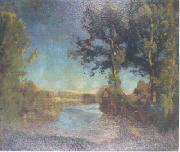 |
Otto Reiniger -- Click Here
|
|
painted Neckar landscape in 1903 |
|
|
|
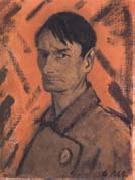 |
Otto Muller -- Click Here
|
|
1874-1930
was a German painter and printmaker of the Die Br??cke expressionist movement. Otto Mueller was born in Liebau (now Lubawka, Kamienna G??ra County), Kreis Landeshut, German Silesia. Between 1890-1892 he was trained in lithography in Görlitz and Breslau. From 1894 to 1896 he studied at the Academy of Fine Arts in Dresden and continued his study in Munich 1898. He left Munich's academy after Franz von Stuck classified him as untalented. His early works are influenced by impressionism, Jugendstil and symbolism. When he settled to Berlin in 1908, he turned more and more to the expressionism. During this time there were meetings with Wilhelm Lehmbruck, Rainer Maria Rilke and Erich Heckel. In 1910, he joined 'Die Br??cke', a Dresden-based group of Expressionist artists. He was member of the group until it disbanded in 1913 due to artistic differences. At the same time Mueller also had contact with the artists group of the 'Blaue Reiter'. During the World War I he fought as a German soldier in France and Russia. After the war he became professor at the academy of arts (Akademie der Bildenden Kunste) in Breslau where he taught until his death on September 24, 1930. Johnny Friedlaender and Isidor Ascheim were among his pupils there. Altogether his printmaking amounted to 172 prints, in woodcut, etching and lithography. In 1937 the Nazis seized 357 of his works from German museums, since the pictures were considered as degenerate art. Mueller was one of the most lyrical of German expressionist painters. The central topic in Mueller's works is the unity of humans and nature, whereas his paintings are focused on a harmonious simplification of form, colour and contours. |
|
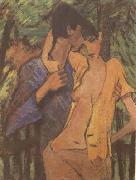 |
Otto Mueller -- Click Here
|
|
German Painter, 1874-1930
Otto Mueller was born on October 16, 1874, in Liebau, German Silesia. His mother had been adopted as a young girl, giving rise to the story that he was the son of a gypsy - a story he never denied. He was a cousin to the famous German writers and dramatists Gerhart and Carl Hauptmann (the latter's novel "Einhart der Lächler" is an imaginary portrait of the painter). After four years of apprenticeship with a lithographer, Mueller entered the Academy of Fine Arts in Dresden in 1894. He was dissatisfied with the conservative instructions and left after two years. The next several years he lived close to his influential cousins, and for a short while he went to Munich to study with the famous painter Franz von Stuck. Information about his life and work until 1908 - when he settled in Berlin - is sketchy, especially since the artist destroyed many of his earlier works. In Berlin Mueller met the expressionist sculptor Wilhelm Lehmbruck, whose concept of the human form had a decisive influence on his own perception. When in 1910 his entries to the exhibition of the Berlin Secession were rejected he joined the members of the artist group "Die Brecke" (The Bridge) and exhibited with the New Secession and thus met Ernst Ludwig Kirchner, Ernst Heckel, and Karl Schmidt-Rottluff. He became their lifelong friend, and, while only slightly influenced by their woodcut techniques, he contributed in return his experience in lithography and especially his techniques of distemper painting (colors bound by glue or size). This technique permits the quick coverage of large areas of the very rough canvas (burlap) which he preferred and adds a subdued luminosity. Since overpainting in distemper is not possible, the artist has to have a clear conception of his work before he begins. The technical devices strengthened the Brecke painters' desire to "flatten" the image on the canvas - following the examples of Paul Gauguin and even Edvard Munch and rejecting the academic preference for an emphasis on three-dimensionality of the subject. In his graphic works Mueller experimented with mixtures of woodcut and lithography, the rubbing of the printer's ink, frequently adding color in the form of watercolor or colored chalk, until he had the technical means of the Breslau Academy available to make true color lithographs. His "Gypsy-Portfolio" (nine color lithographs in a portfolio of 1927), which used as many as five stones, is one of his great achievements as a graphic artist. From 1916 to 1918 he served as a soldier in World War I, an experience which left no impact on his work. Shortly after his return he was appointed professor at the Breslau Academy of Art, where he taught until his death. Mueller's work shows only three motifs: landscapes, gypsies, and primarily nudes in landscapes. The last motif dominated his work. The earthen color of his mostly young, subtle but angular nude girls forms with the subdued and delicate greens of the landscape backgrounds a vision of a lost past. There is a frequently melancholic nostalgia in his works, presenting a harmony between nature and the human form which is not only opposite to the academic approach but also to that of the other Expressionists. |
|
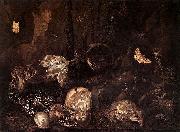 |
Otto Marseus van Schrieck -- Click Here
|
|
(ca. 1619, Nijmegen - buried June 22, 1678, Amsterdam) was a painter in the Dutch Golden Age.
Marseus van Schrieck spent the years 1648-1657 in Rome and Florence with the painters Matthias Withoos and Willem van Aelst, after which he settled in Amsterdam. He is best known for his paintings of forest flora and fauna. In Arnold Houbraken's biography of him, he mentions that he joined the Bentvueghels in Rome and was called the snuffelaer, or "sniffer", because he was always sniffing strange lizards and snakes. He quotes his wife, who apparently survived him by two husbands and was still alive when he wrote the book. He wrote that she said that Otto kept snakes and lizards in a shed at the back of his house, and also on a piece of land outside the city that was walled in for this purpose.
|
|
|
|
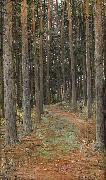 |
Otto Hesselbom -- Click Here
|
|
painted The Forest in 1897 |
|
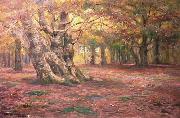 |
Otto Hennig -- Click Here
|
|
Germany (1826 -1899 ) - Painter
|
|
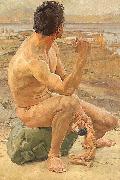 |
Otto Greiner -- Click Here
|
|
painted Prometheus in 1909 |
|
|
|
|
|
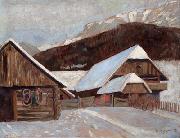 |
Otto Barth -- Click Here
|
|
(18 June 1891 - 3 May 1963) was a highly decorated Generalmajor in the Wehrmacht during World War II who commanded the 30. Infanterie-Division. He was also a recipient of the Knight's Cross of the Iron Cross. The Knight's Cross of the Iron Cross was awarded to recognise extreme battlefield bravery or successful military leadership. Otto Barth was captured by Soviet troops following the fall of the Courland Pocket in 1945. He was held until 1955.
|
|
|
|
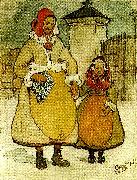 |
ottilia adelborg -- Click Here
|
|
Eva Ottilia Adelborg, född 6 december 1855 i Karlskrona, död 19 mars 1936, var en svensk akvarellkonstnär. Hon var dotter till kommendörkapten Bror Jacob Adelborg och hans hustru Hedvig Catharina af Uhr samt syster till Gertrud Adelborg.
Adelborg var "bilderbokskonstnärinna" enligt äldre benämning. Hon benämns idag barnboksillustratör, men illustrerade även böcker för vuxna, komponerade tapetmönster och skrev böcker och kan därför benämnas författare. Bosatt i Gagnef i Dalarna från juli 1903, då hon startade en skola för knyppling. Museum över hennes liv och verksamhet finns i Gagnefs gamla prostgård. Känd för bland annat affischen "Prinsarnes blomsteralfabet" (1892). Det litterära Ottilia Adelborg-priset instiftades år 2000 av Gagnefs kommun. |
|
|
|
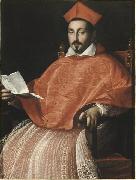 |
Ottavio Leoni -- Click Here
|
|
Ottavio Leoni (1578 - 1630) was an Italian painter and printmaker of the early-Baroque, active mainly in Rome.
He was born in Rome, where he first trained with his father, Lodovico Leoni. He painted altarpieces for churches in Rome such as an Annunciation for Sant'Eustachio and a Virgin and child with St. Giacinto for Santa Maria della Minerva, and a Saints Charles, Francis, & Nicholas for Sante Urbano. He became a member, and later president, of the Accademia di San Luca and a Cavalieri of the Order of Christ, on which occasion he presented the church of the Academy the Martyrdom of St. Martina. He died in Rome. Ottavio Leoni was also the engraver of a set of portraits of painters. His portrait of Michelangelo Merisi Caravaggio is the only documented portrait of the painter by another artist.
His work is exhibited in places such as Fine Arts Museums of San Francisco; Museum of Fine Arts, Boston; National Gallery of Art; Bowes Museum; Courtauld Institute of Art; Los Angeles County Museum of Art; and Palazzo Ruspoli, Rome, Italy. |
|
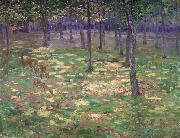 |
Otakar Lebeda -- Click Here
|
|
painted Z bechynske obory - Srnky in 1899 |
|
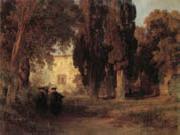 |
Oswald achenbach -- Click Here
|
|
German Painter, 1827-1905
was a German landscape painter. Born in Desseldorf, he received his art education from his brother, Andreas Achenbach. His landscapes generally dwell on the rich and glowing effects of color which drew him to the Bay of Naples and the neighborhood of Rome. From 1863 to 1872 he was Professor of Landscape Painting at the Desseldorf Academy. He died in Desseldorf of an inflammation of the lungs. |
|
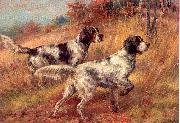 |
Osthaus, Edmund Henry -- Click Here
|
|
American, 1858-1928 |
|
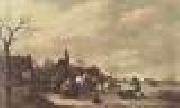 |
OSTADE, Isaack van -- Click Here
|
|
Dutch Baroque Era Painter, 1621-1649 |
|
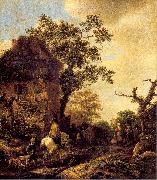 |
Ostade, Isaack Jansz. van -- Click Here
|
|
Dutch Baroque Era Painter, 1621-1649 |
|
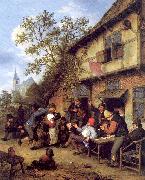 |
Ostade, Adriaen van -- Click Here
|
|
Dutch Baroque Era Painter, 1610-1685
Painter, draughtsman and etcher. According to Houbraken's rather unreliable biography, he was a pupil concurrently with Adriaen Brouwer of Frans Hals in Haarlem. Hals influenced him very little, whereas Brouwer, who was described as 'known far and wide' as early as 1627, had a decisive influence on the evolution of Adriaen van Ostade's always idiosyncratic portrayal of peasant life. The first documentary mention of Adriaen van Ostade as a painter is in 1632 (Schnackenburg, 1970). Most of his paintings are signed and dated, the earliest firmly dated example being the Peasants Playing Cards (1633; St Petersburg, Hermitage). |
|
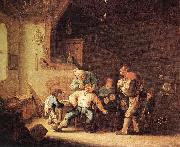 |
OSTADE, Adriaen Jansz. van -- Click Here
|
|
Dutch painter (b. 1610, Haarlem, d. 1685, Haarlem).
|
|
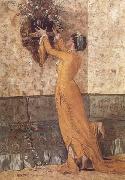 |
Osman Hamdy Bey -- Click Here
|
|
Turkey, born 1842 - died 1910 |
|
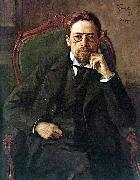 |
Osip Braz -- Click Here
|
|
painted Portrait of Anton Pavlovich Chekhov in 1898 |
|
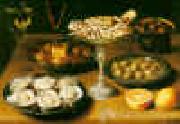 |
Osias Beert -- Click Here
|
|
1580-1624
Flemish
Osias Beert Galleries
Flemish painter. In 1596 he went to study with Andries van Baseroo and in 1602 became a master in the Antwerp Guild of St Luke; these two dates suggest his probable date of birth. Beert married Marguerite Ykens on 8 January 1606. Contemporary documents describe him as a cork merchant. The esteem enjoyed by Beert is indicated by the large number of pupils he had, including, in 1610, Frans van der Borch; in 1615, Frans Ykens; in 1616, Paulus Pontius; and, in 1618, Jan Willemssen. Beerts son, Osias Beert the younger (1622-78), was also a painter and became a master in 1645.
|
|
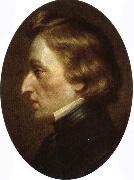 |
oscar wilde -- Click Here
|
|
Born: 16 October 1854
Birthplace: Dublin, Ireland
Died: 30 November 1900
Best Known As: The author of The Importance of Being Earnest
|
|
|
|
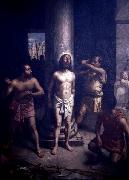 |
Oscar Pereira da Silva -- Click Here
|
|
(1867-1939 ) - Painter |
|
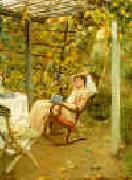 |
Oscar Bluhm -- Click Here
|
|
German Painter, 1867-1912 |
|
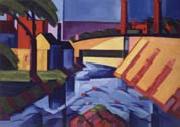 |
Oscar Bluemner -- Click Here
|
|
German-born American Painter, 1867-1938,was a German-born American Modernist painter. He was born in Hanover, Germany. He moved to Chicago in 1893 where he freelanced as a draftsman. He relocated to New York in 1901. In 1910 he met Alfred Stieglitz, who introduced him to the artistic innovations of the European and American avant-garde. Then in 1915 Stieglitz gave him a solo exhibition at his gallery, 291. |
|
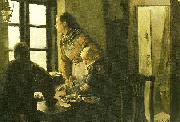 |
oscar bjorck -- Click Here
|
|
född 15 januari 1860 i Stockholm, död av en hjärtattack i sitt hem klockan 03.00 den 5 december 1929, var en svensk konstnär och professor vid Konsthögskolan 1898-1925, och från 1918 även vice preses.
Åren 1877-1882 var han elev till Edvard Pers??us vid konstakademins principskola och målade bland annat prisämnena Loke fängslas af asarne (1880), Gustaf Vasa inför kung Hans (1881) och Den förlorade sonens återkomst (1882, belönad med kungliga medaljen). 1883 fick Björck akademiskt resestipendium och vistades vintern 1883?C84 i Paris. Vintern 1884?C85 reste Björck till M??nchen, målade några porträtt, bland annat ett i helfigur av sin hustru. Våren 1885 flyttade han till Venezia och på hösten till Rom. Där målade han den stora modelltavlan Susanna (Göteborgs museum) och Romerska smeder (galleriet i Washington, en skiss till samma tavla finns i Göteborgs museum). 1887 målades i Venezia Veneziansk saluhall (nationalmuseum), Lördagsmässa i Markuskyrkan och andra tavlor.
Efter en sommarvistelse på Skagen, där han förut tillbringat två somrar, 1882 och 1884, bosatte sig Björck 1888 i Stockholm. Han har sedan huvudsakligast målat porträtt. Bland dessa kan nämnas flera av konung Oscar (bland dem ett på Skokloster, ett i helfigur på Drottningholm, ett med krona och mantel, på Stockholms slott, ett som övergick i tyske kejsarens ägo), prins Eugen vid staffliet (nationalmuseum, 1895), kronprins Gustaf (Stockholms slott, 1900), konstnärens hustru (helfigur, 1891, Göteborgs museum) och friherre Nordenfalk (konstakademien, 1892). Dessutom skapade han några landskap, ett par genrebilder och olika dekorativa målningar.
Från 1889 var han ledamot vid konstakademin och lärare vid Konsthögskolan. 1898 blev han professor.
Björck var kommissarie för konstavdelningen vid Stockholmsutställningen 1897 och vid Baltiska utställningen 1914 samt för den svenska utställningen i London 1924. |
|
|
|
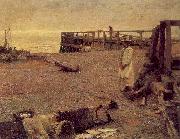 |
Osborne, Walter -- Click Here
|
|
Irish, 1859-1903
Irish painter. The son of the animal painter William Osborne (1823-1901), he trained in the schools of the Royal Hibernian Academy (1876-81). In 1881 he won the Royal Dublin Society's Taylor scholarship and went to study at the Koninklijk Academie voor Schone Kunsten, Antwerp. Charles Verlat was the professor of painting, and Antwerp was then at the height of its popularity with students from the British Isles. In Antwerp and subsequently in Brittany, Osborne made contact with painters of the Newlyn school and other British naturalists. In Brittany he painted Apple Gathering, Quimperle (1883; Dublin, N.G.), a small greenish-grey picture of a girl in an orchard, which in subject and treatment shows the influence of Jules Bastien-Lepage. Throughout the 1880s Osborne worked in England, joining groups of artists in their search for the ideal naturalist motif. In the autumn of 1884 he was at North Littleton, near Evesham (Heref. & Worcs), where he painted Feeding Chickens in weather so cold that his model, a young peasant girl, nearly fainted. It is carefully drawn but painted with the square-brush technique characteristic of Bastien-Lepage's followers, and is very close to the contemporary work of George Clausen and Edward Stott (1855-1918). At Walberswick in Suffolk he painted October Morning (1885; London, Guildhall A.G.), a carefully studied plein-air work using bright dots of pure colour on a base of beige and grey. During this time Osborne gave careful attention to the showing of his work. He exhibited regularly at the Royal Hibernian Academy in Dublin from 1877 and at the Royal Academy in London from 1886. |
|
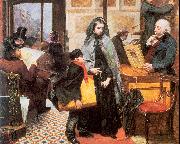 |
Osborn, Emily Mary -- Click Here
|
|
English, 1834-1893 |
|
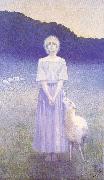 |
Osbert, Alphonse -- Click Here
|
|
French Symbolist Painter, 1857-1939
French painter. He studied at the Ecole des Beaux-Arts and in the studios of Henri Lehmann, Fernand Cormon and L?on Bonnat. His Salon entry in 1880, Portrait of M. O. (untraced), reflected his early attraction to the realist tradition of Spanish 17th-century painting. The impact of Impressionism encouraged him to lighten his palette and paint landscapes en plein air, such as In the Fields of Eragny (1888; Paris, Y. Osbert priv. col.). By the end of the 1880s he had cultivated the friendship of several Symbolist poets and the painter Puvis de Chavannes, which caused him to forsake his naturalistic approach and to adopt the aesthetic idealism of poetic painting. Abandoning subjects drawn from daily life, Osbert aimed to convey inner visions and developed a set of pictorial symbols. Inspired by Puvis, he simplified landscape forms, which served as backgrounds for static, isolated figures dissolved in mysterious light. A pointillist technique, borrowed from Seurat, a friend from Lehmann's studio, dematerialized forms and added luminosity. However, Osbert eschewed the Divisionists' full range of hues in his choice of blues, violets, yellows and silvery green. Osbert's mysticism is seen in his large painting Vision |
|
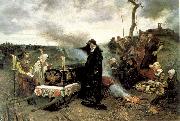 |
Ortiz, Francisco Pradilla -- Click Here
|
|
Spanish, 1848-1921
Spanish painter and museum official. He first studied in Saragossa with the stage designer Mariano Pescador (d 1886), and in 1866 moved to Madrid where he began to work with the stage designers and decorators Ferri and Busato. He entered the Escuela Superior de Pintura, Escultura y Grabado and also attended the Academia de Acuarelistas. In 1873 Pradilla and his fellow student Casto Plasencia (1846-90) won history painting scholarships to study at the newly founded Academia Espaola de Bellas Artes in Rome. In 1874 he sent from Rome a copy of Raphael's Dispute over the Holy Sacrament, a work Pradilla completed in collaboration with Alejandro Ferrant (b 1844), another Spanish scholarship holder. During Pradilla's second and third years abroad he travelled through France, visiting the Paris Exposition Universelle of 1875, and Italy, where he was particularly impressed by Venice and the works of Veronese, Titian and Jacopo Tintoretto. Pradilla won a major prize in 1878 at the Exposicien Nacional de Bellas Artes in Madrid; as a result of this success he received the commission for another large picture on a historical theme, the Surrender of Granada (1882; in situ) for the Palacio del Senado (now Pal. de las Cortes) in Madrid. This work shows Pradilla's concern to paint from life in his treatment of the landscape of Granada. He produced other paintings on related subjects, including Mad Queen Joanna Imprisoned at Tordesillas (priv. col., see Pardo Canalis, pl. xviii) and the Sigh of the Moor (Madrid, Rodriguez Bauz priv. col., see Pardo Canalis, pl. xvii). Pradilla also painted lively scenes of local life and colour. The years of his stay in Rome, where he was director of the Academia Espaola between 1881 and 1883, allowed him to get to know the country around Rome and many other places in Italy. |
|
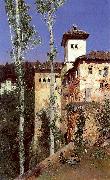 |
Ortega, Martin Rico y -- Click Here
|
|
Spanish, 1833-1908 |
|
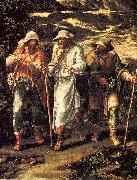 |
Orsi, Lelio -- Click Here
|
|
Italian, approx. 1508-87
.Italian painter and draughtsman. A prominent Emilian artist of the mid-16th century, he was influenced by Correggio as well as by the late Mannerist style of Giulio Romano. His large-scale works seem to have been mainly secular decorations, notably illusionistic fa?ades, of which only fragments are extant. Their energy and expressiveness are apparent, however, in the surviving paintings of smaller dimensions. Orsi's sole documented architectural work is the Collegiata di S Stefano, Novellara |
|
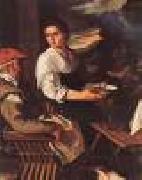 |
ORRENTE, Pedro -- Click Here
|
|
Spanish Baroque Era Painter, 1580-1645
Spanish painter. He is one of the most interesting artists of his day. His father, Jaime Orrente, was a merchant from Marseille, his mother, Isabel Jumilla, from Murcia. By 1600 Orrente was active in Toledo, where he was commissioned to paint a retable (untraced). In 1607 and again in 1611 he was in Murcia, and a journey to Italy recorded by Jusepe Mart?nez and Palomino must have taken place between those years. It seems certain that he visited Venice and met Leandro Bassano |
|
|
|
|
|
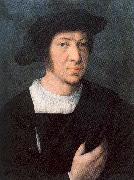 |
Orlandi, Deodato -- Click Here
|
|
Flemish Northern Renaissance Painter, ca.1488-1541 |
|
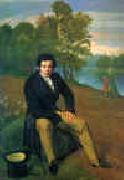 |
Orest Kiprensky -- Click Here
|
|
1782-1836
Russian
Orest Kiprensky Galleries
Orest was born in the village of Koporye near Saint Petersburg on 24 March [O.S. 13 March] 1782. He was an illegitimate son of a landowner Alexey Dyakonov, hence his name, derived from Kypris, one of the Greek names for the goddess of love. He was raised in the family of Adam Shvalber, a serf. Although Kiprensky was born a serf, he was released from the serfdom upon his birth and later his father helped him to enter a boarding school at the Imperial Academy of Arts in Saint Petersburg in 1788 (when Orest was only six years old).
He studied at the boarding school and the Academy itself until 1803. He lived at the Academy for three more years as a pensioner to fulfill requirements necessary to win the Major Gold medal. Winning the first prize for his work Prince Dmitri Donskoi after the Battle of Kulikovo (1805) enabled the young artist to go abroad to study art in Europe.
A year before his graduation, in 1804, he painted the portrait of Adam Shvalber, his foster father (1804), which was a great success. The portrait so impressed his contemporaries, that later members of the Naples Academy of Arts took it for the painting by some Old Master - Rubens or van Dyck. Kiprensky had to ask the members of the Imperial Academy of Arts for letters supporting his authorship.
Wikimedia Commons has media related to: Orest Kiprensky
After that, Kiprensky lived in Moscow (1809), Tver 1811, Saint Petersburg 1812, in 1816-1822 he lived in Rome and Napoli. In Italy he met a local girl Anne Maria Falcucci (Mariucci), to whom he became attached. He bought her from her dissolute family and employed as his ward. On leaving Italy, he sent her to a Roman Catholic convent.
In 1828, Kiprensky came back to Italy, as he got a letter from his friend Samuel Halberg, informing him that they had lost track of Mariucci. Kiprensky found Mariucci, who had been transferred to another convent. In 1836 he eventually married her. He had to convert into Roman Catholicism for this marriage to happen. He died by pneumonia in Rome later that year.
|
|
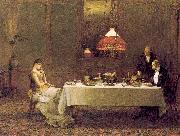 |
Orchardson, Sir William Quiller -- Click Here
|
|
English, 1832-1910 |
|
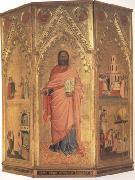 |
Orcagna -- Click Here
|
|
b Florence c 1320 d Florence 1368 |
|
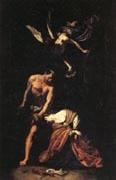 |
Orazio Riminaldi -- Click Here
|
|
Italian painter
b. 1593, Pisa, d. 1630, Pisa |
|
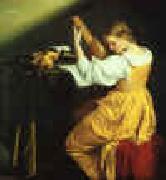 |
Orazio Gentileschi -- Click Here
|
|
1563-1639 Italian Orazio Gentileschi Galleries Tuscan painter, b. Pisa. His real surname was Lomi, but he adopted his uncle name. He studied in Rome, where he was associated with Agostino Tassi in the decoration of palace interiors. Influenced by Caravaggio, Gentileschi developed a more softly luminous light and a cooler, more lyrical style. He also painted frescoes in Santa Maria Maggiore and in the Lateran. After spending several years in Genoa and in France, he settled in England (1626) at the invitation of Charles I. Gentileschi principal works include The Annunciation (San Siro, Genoa); Flight into Egypt (Louvre); Sibyl (Hampton Court, England); and Moses Saved from the Waters (Prado). He also painted numerous portraits. Artemesia Gentileschi was his daughter. |
|
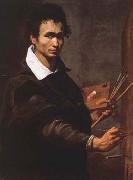 |
Orazio Borgianni -- Click Here
|
|
Italian Baroque Era Painter, 1578-1616 |
|
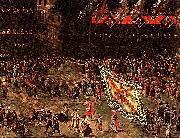 |
oranien -- Click Here
|
|
han mordades 1584 pa uppdrag av filip . i ett hus som idag ar museum over det nederlandska frihetskriget
se |
|
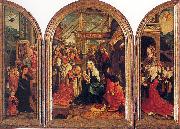 |
Oostsanen, Jacob Cornelisz van -- Click Here
|
|
Flemish, 1472-1533 |
|
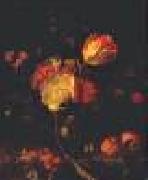 |
OOSTERWIJK, Maria van -- Click Here
|
|
Dutch woman painter (b. 1630, Nootdorp, d. 1693, Uitdam)
was a Dutch Baroque painter, specializing in richly detailed still lifes. She was a student of Jan Davidsz de Heem. Van Oosterwijk worked in Delft and later in Amsterdam (1675-1689), where she lived opposite the workshop of Willem van Aelst. She was popular with European royalty, including Emperor Leopold, Louis XIV of France and William III of England. Despite this, as a woman, she was not allowed to join the painters' guild. Her work is in many prominent collections, including the Fitzwilliam Museum (Cambridge), the Kunsthistorisches Museum (Vienna), the Palatine Gallery in Palazzo Pitti (Florence), the Royal Collection |
|
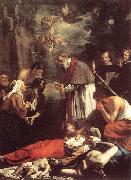 |
OOST, Jacob van, the Younger -- Click Here
|
|
Flemish painter (b. 1639, Brugge, d. 1713, Brugge) |
|
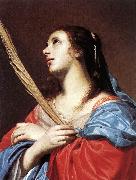 |
OOST, Jacob van, the Elder -- Click Here
|
|
Flemish Baroque Era Painter, ca.1601-1671 |
|
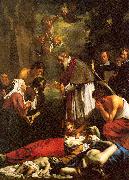 |
Oost, Jacob van the Younger -- Click Here
|
|
Flemish, 1637-1713 |
|
|
|
|
| | |
|
|
|
|